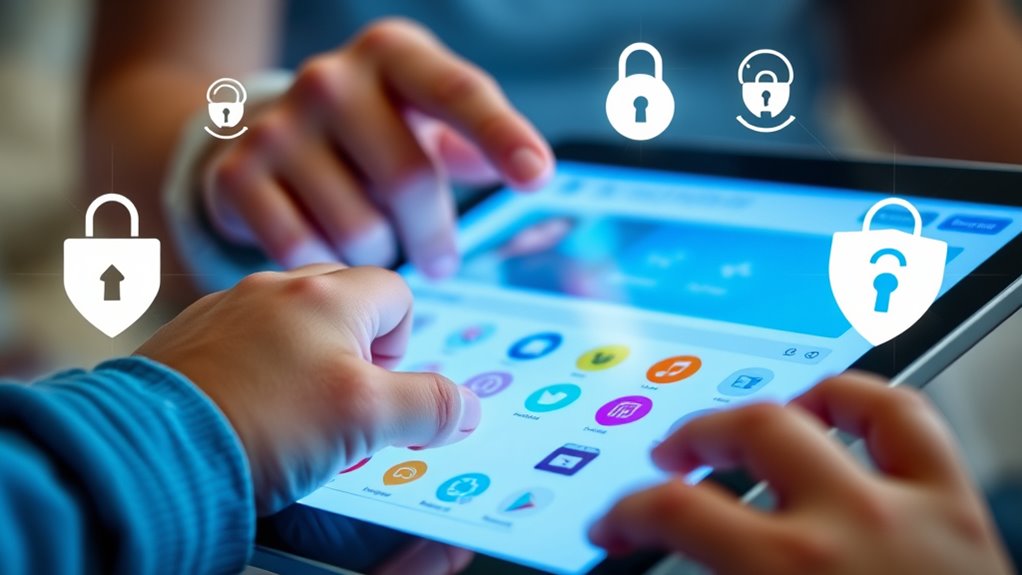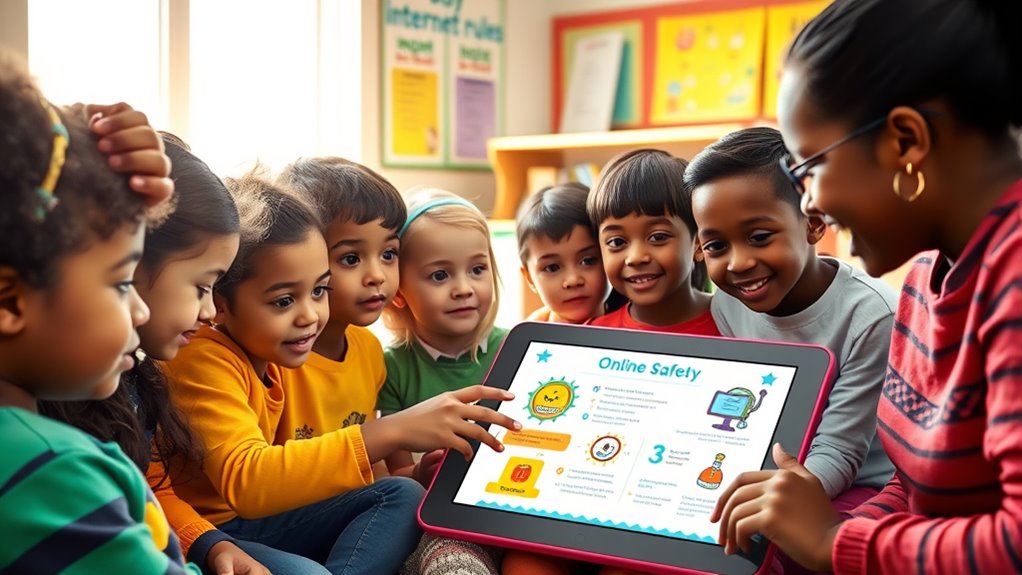To protect children online, set clear rules and boundaries, including supervised screen time and safe browsing guidelines. Use parental control software and filters to monitor activity and keep devices updated for security. Teach your kids about online safety, privacy, and responsible behavior, encouraging open conversations about their experiences. Model respectful online habits yourself. By taking these steps, you’ll create a safer digital environment, and discovering more ways can help further safeguard your child.
Key Takeaways
- Establish clear rules, boundaries, and open communication about online activities and safety.
- Use parental control tools and regularly update device security settings.
- Educate children on online safety, privacy, and responsible digital behavior.
- Promote digital well-being by encouraging mindful internet use and respectful interactions.
- Foster trust and proactive habits to help children navigate and report online risks effectively.
Set Clear Rules and Boundaries for Internet Use

To effectively protect children online, you need to establish clear rules and boundaries for internet use. Start by setting digital boundaries that define what is acceptable and safe. Explain to your child the importance of respecting these boundaries and sticking to designated online activities. Managing screen time is essential; decide how long they can spend online each day and stick to it. Use specific rules, such as no devices during mealtimes or before homework, to help your child develop healthy habits. Consistency is key—regularly review and adjust these boundaries as your child grows. Clear rules create a safe online environment, reducing the risk of exposure to harmful content and fostering responsible digital behavior. Incorporating on-device AI capabilities can help monitor and manage your child’s online activity more effectively.
Use Parental Control Software and Filtering Tools

Implementing parental control software and filtering tools is an effective way to reinforce the boundaries you’ve set for online activities. These tools allow you to monitor app usage, so you can see which apps and websites your child accesses. You can also customize content filters to block inappropriate sites and limit screen time, ensuring they’re engaging with suitable content. Parental control software offers real-time alerts if your child attempts to access restricted areas, giving you peace of mind. By actively managing these settings, you help create a safer online environment tailored to your child’s age and maturity. This proactive approach not only protects them from harmful content but also encourages responsible digital habits. Use these tools consistently to maintain oversight and support healthy online boundaries.
Educate Children About Online Safety and Privacy

Have you explained to your children how to stay safe and protect their privacy online? Teaching kids about online safety is essential. Start by discussing cyberbullying awareness, so they recognize harmful behavior and know how to respond. Emphasize the importance of managing their digital footprint—reminding them that their online actions leave a lasting record. Encourage them to think before sharing personal information, photos, or opinions. Explain that privacy settings are tools to help control who sees their content. Reinforcing these lessons helps children understand the risks and develop responsible online habits. By educating them early, you empower your kids to navigate the internet confidently, reducing their chances of falling victim to cyberbullying or privacy breaches. Additionally, teaching children about the use of privacy policies and how websites collect and store their data can further enhance their understanding of online safety.
Encourage Open Communication and Supervision

Building on the importance of educating children about online safety, fostering open communication and ongoing supervision creates a foundation for responsible internet use. Regular parent-child conversations help your child feel comfortable sharing their online experiences, concerns, or questions. Use trust-building exercises to strengthen this connection, making it easier for them to approach you if something feels wrong. Supervision doesn’t mean spying; it’s about being present and engaged with their online activities. Set clear boundaries and check in frequently, showing your interest and support. When your child knows they can talk openly without judgment, they’re more likely to seek your guidance. This open dialogue and active supervision help create a safe online environment and reinforce responsible digital habits.
Teach Children to Recognize and Avoid Online Risks

Since children often encounter online risks without realizing it, teaching them to recognize these dangers is essential. Start by explaining cyberbullying awareness, so they understand what it looks like and how to respond. Encourage them to think before sharing personal information online, emphasizing digital footprint management to prevent future issues. Show them how harmful comments or messages can impact others and themselves. Teach them to identify suspicious links, scams, or inappropriate content, reinforcing the importance of not engaging with unknown contacts. Reinforce that they should come to you if they feel uncomfortable or encounter something upsetting. Additionally, educating children about powerful persuasive words used in online content can help them recognize manipulation or scams. By actively helping your children recognize online risks, you’re empowering them to stay safe and make smart choices in their digital lives.
Keep Devices Secure and Up-to-Date

Keeping devices secure is essential to protecting your child online. You should regularly update software, enable automatic updates, and choose strong passwords to prevent unauthorized access. These simple steps help guarantee devices stay safe and protected from threats. Additionally, implementing mindfulness techniques on device use can help children develop healthier digital habits and reduce screen time overload.
Regular Software Updates
Have you ever wondered why your device prompts you to install updates? These updates are essential because they fix software vulnerabilities that hackers can exploit. Regular software updates help close security gaps before malicious actors can take advantage of them. If you ignore these prompts, your device becomes more vulnerable to cyber threats, putting your child’s safety at risk. Update frequency varies depending on the device and software, but it’s best to install updates as soon as they’re available. Keeping your device current ensures you have the latest security patches, reducing the chance of malware infections or data breaches. Staying vigilant about updates is a simple yet effective way to protect your children’s online experience and keep their devices secure. Additionally, software vulnerabilities are often exploited due to outdated firmware or operating systems, making timely updates crucial.
Enable Automatic Updates
Enabling automatic updates guarantees your devices stay current without you having to remember to install each update manually. This simple step is vital for cybersecurity best practices because it guarantees your devices receive the latest security patches and bug fixes promptly. By turning on automatic updates, you reduce vulnerabilities that hackers can exploit, keeping your children’s online environment safer. Many operating systems and apps now offer automatic update options, so it’s easy to set and forget. Regularly updating your devices helps protect sensitive information, prevent malware infections, and maintain peak performance. Incorporating risk management strategies into your routine as a proactive way to keep all devices secure and up-to-date supports a safer online experience for your children.
Use Strong Passwords
Using strong, unique passwords is essential to keep your devices secure and guarantee they stay up-to-date. Good password strength prevents unauthorized access and enhances your account security. To achieve this, avoid simple or common passwords like “123456” or “password.” Instead, create complex combinations that are hard to guess. A strong password also helps protect your personal information and digital well-being. Password security practices are vital for safeguarding all your online accounts. Using a different password for each account and updating passwords regularly to stay ahead of potential threats
Model Responsible Online Behavior

How can children learn to navigate the online world responsibly? The best way is by modeling responsible online behavior yourself. Show them how to think before sharing, which helps manage their digital footprint. Demonstrate respectful communication to prevent cyberbullying and promote cyberbullying prevention. When you interact kindly and responsibly online, children learn to do the same. Be transparent about your online activities, explaining why you avoid gossip or harmful comments. Encourage open conversations about online experiences and consequences. By setting a positive example, you teach children to be mindful of their actions and the impact they have on others. Understanding electric dirt bikes and their features can also inspire responsible decision-making in related areas. This proactive approach helps them develop safe habits, making the internet a safer space for everyone.
Frequently Asked Questions
How Can I Tell if My Child Is Encountering Online Dangers?
You can tell if your child faces online dangers by watching for signs like changes in behavior or secretive internet habits. Talk openly about digital footprints and online privacy to encourage honesty. Monitor their online activity gently and review privacy settings on their devices. If you notice unfamiliar contacts or risky content, address it directly. Staying involved helps you spot issues early and keeps your child safe from digital threats.
What Are the Signs of Cyberbullying or Online Harassment?
If you’re trying to recognize emotional distress or identify social withdrawal, look for signs like your child becoming unusually secretive, upset after online activity, or avoiding friends and family. They might seem anxious, moody, or withdrawn, which can indicate cyberbullying or online harassment. Pay attention to any changes in behavior, communication patterns, or mood, and keep open lines of dialogue to help them feel safe sharing their online experiences.
How Do I Handle My Child’s Resistance to Online Safety Rules?
When your child pushes back against online safety rules, it’s a gentle dance of setting boundaries and fostering communication. Stay calm and listen to their concerns, showing understanding rather than frustration. Explain why these rules exist, emphasizing safety and trust. Encourage open dialogue, making them feel involved in the process. By maintaining a supportive attitude, you help your child see online safety as a shared goal, not a punishment.
Are There Age-Appropriate Online Platforms for Children?
You’ll find many age-appropriate content options through child-friendly platforms designed specifically for kids. These platforms offer age-appropriate content, ensuring your child engages with safe, educational, and entertaining material. By choosing reputable child-friendly platforms, you help your child explore online safely and responsibly. Always check for platforms with strong parental controls and clear privacy policies to keep your child protected while they enjoy suitable online experiences.
How Often Should I Review and Update Online Safety Measures?
Perfectly prioritize your child’s protection by periodically reviewing and updating online safety measures. You should check privacy settings and parental controls at least once a month, especially after software updates or new app downloads. Regular reviews help prevent potential pitfalls, protect personal information, and guarantee safety. Staying proactive, you keep pace with evolving threats, ensuring your child’s online environment remains secure, safe, and suitable for their age and activity.
Conclusion
By setting clear rules, you create a sturdy shield that guards your child’s digital world. With parental controls and open chats, you build bridges of trust and safety. Teaching them to spot dangers is like planting seeds of awareness that grow strong over time. Keep devices updated like shining armor, and model good behavior as guiding stars. Together, you craft a safe, bright path through the online universe, where your child can explore freely but wisely.









